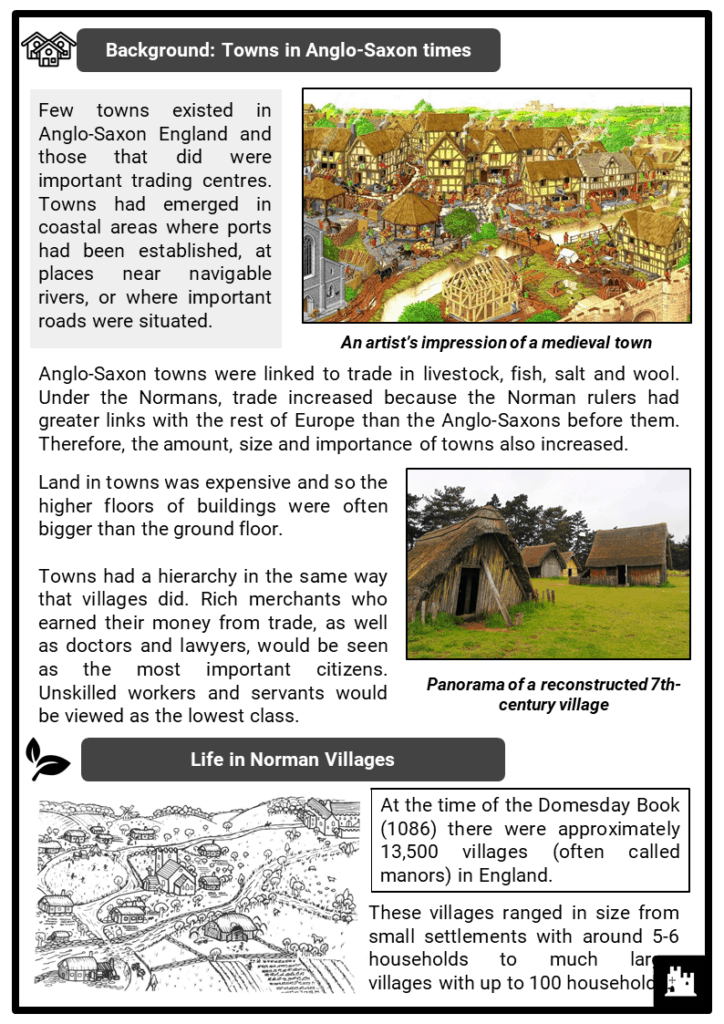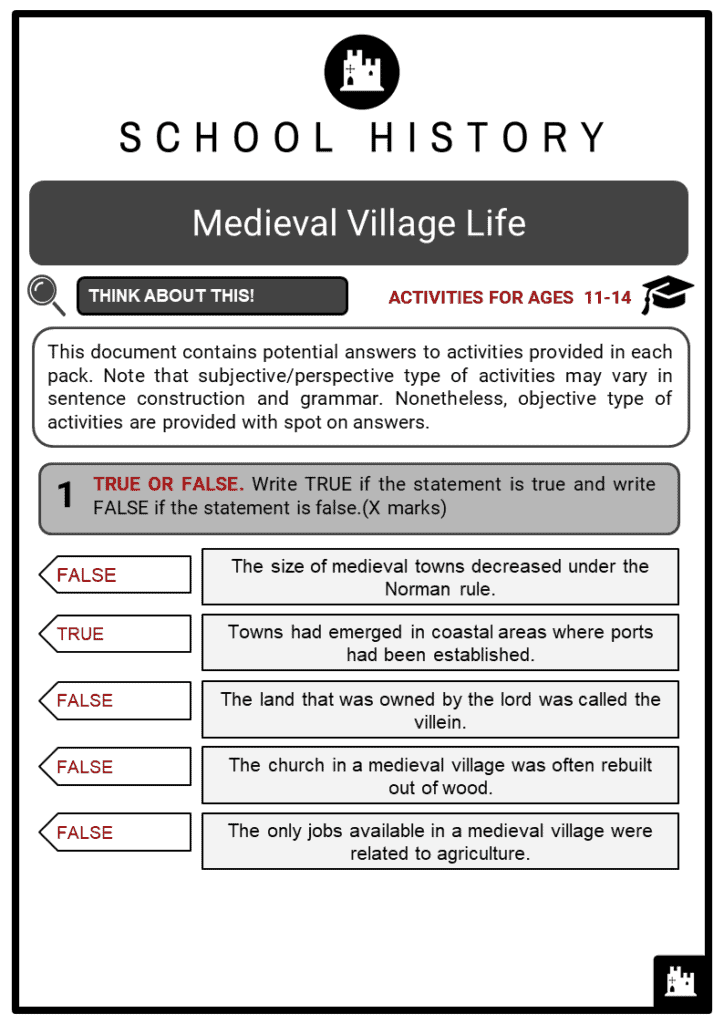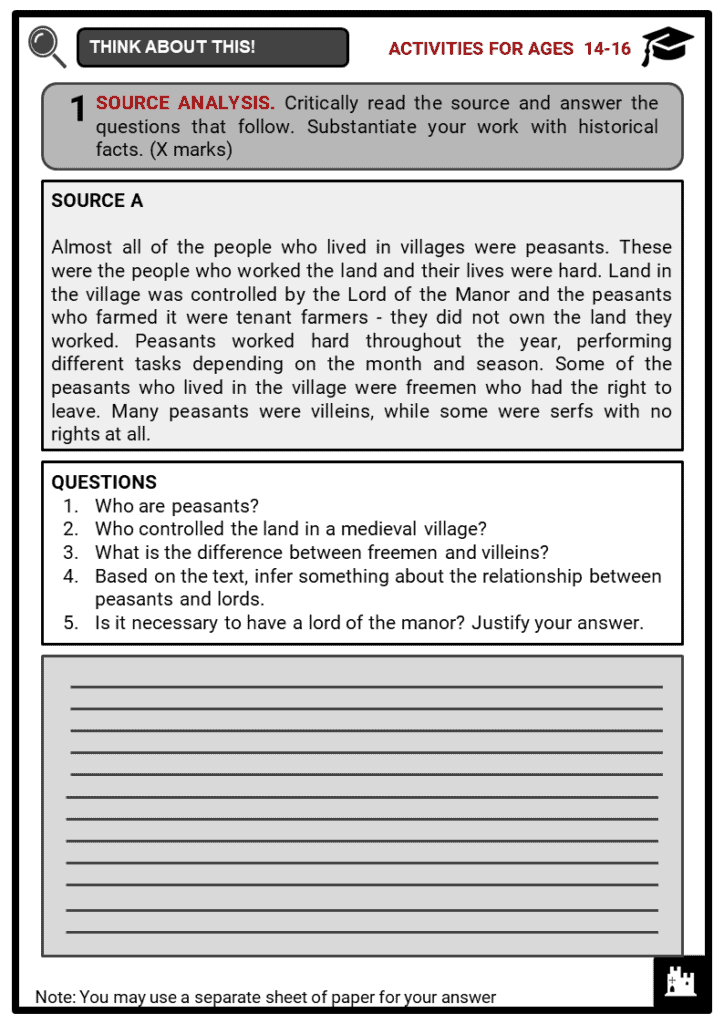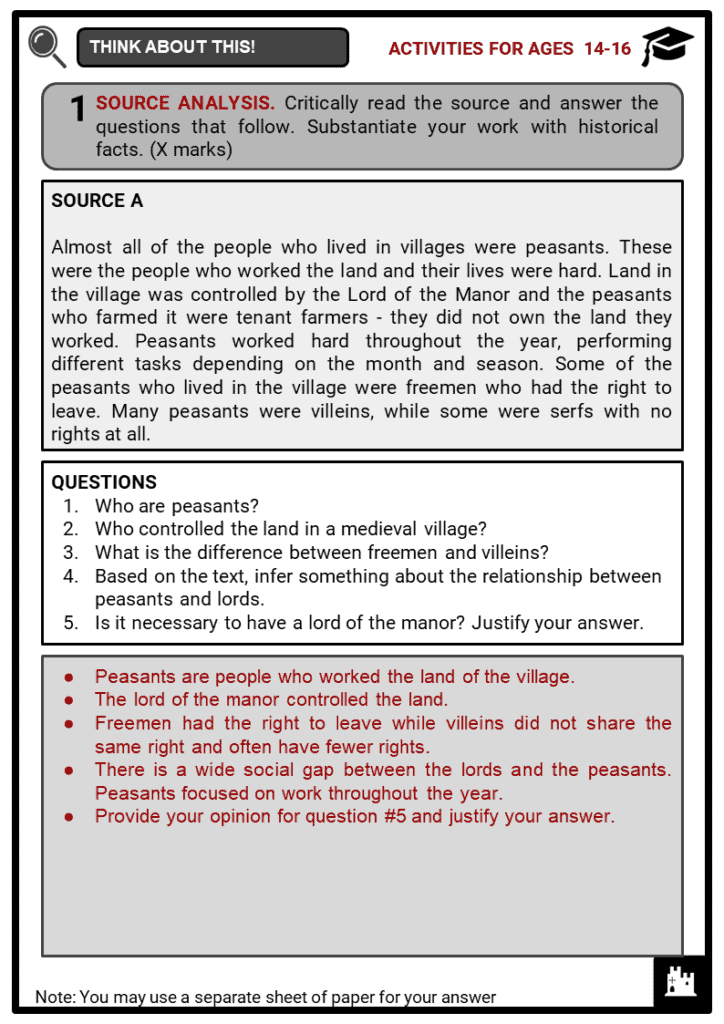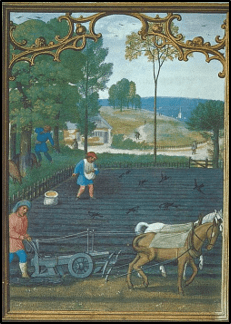Download Medieval Village Life Worksheets
Do you want to save dozens of hours in time? Get your evenings and weekends back? Be able to teach Medieval Village Life to your students?
Our worksheet bundle includes a fact file and printable worksheets and student activities. Perfect for both the classroom and homeschooling!
Table of Contents
Add a header to begin generating the table of contents
Summary
- Structure of a medieval village
- Significance of a medieval manor
- Jobs of people who lived in a medieval village
Key Facts And Information
Let’s know more about Medieval Village Life!
- Before 1066, nearly all people in England lived in the countryside. The majority of the people were peasants who worked the land for a thegn, who owned the land that they farmed.
- Life in Norman England showed a great deal of continuity with Anglo-Saxon times. For example, after 1066, nearly everyone continued to live in villages.
- Norman rule would bring wide-scale and far-reaching changes to life and work in both towns and the countryside.
Background: Towns in Anglo-Saxon times
- Few towns existed in Anglo-Saxon England and those that did were important trading centres. Towns had emerged in coastal areas where ports had been established, at places near navigable rivers, or where important roads were situated.
- Anglo-Saxon towns were linked to trade in livestock, fish, salt and wool. Under the Normans, trade increased because the Norman rulers had greater links with the rest of Europe than the Anglo-Saxons before them. Therefore, the amount, size and importance of towns also increased.
- Land in towns was expensive and so the higher floors of buildings were often bigger than the ground floor.
- Towns had a hierarchy in the same way that villages did. Rich merchants who earned their money from trade, as well as doctors and lawyers, would be seen as the most important citizens. Unskilled workers and servants would be viewed as the lowest class.
Life in Norman Villages
- At the time of the Domesday Book (1086) there were approximately 13,500 villages (often called manors) in England.
- These villages ranged in size from small settlements with around 5-6 households to much larger
villages with up to 100 households. - In villages, there was a certain amount of cultivated land. Much of this was for the villagers to use and the remainder would be for the lord of the manor. The rest of the land in the village was meadow, pasture and woodland.
Manors
- The land that was owned by the lord was called the manor. A manor consisted of a village with land around it. The villeins lived in the village, which was surrounded by three large fields. Each field was divided into long strips. A villein would farm strips in each of the fields.
- This made sure that everyone had a share of the good land and the bad land. The strips were divided by mounds of earth or by rocks.
- Manors were composed of large castles surrounded by small villages and a local church. During this period, about 90% of the population worked on the land as peasants or serfs. Lords and barons swore their oath of fealty to the king.
- Every year, one field was left fallow, or empty, so that the soil could get
- its goodness back. Strip farming meant that villeins had to work together. A whole field would be sown and harvested, and each villein worked closely with his neighbour to get his work done.
- The other land around the village was also important. Villeins collected wood from the woodland, their animals grazed on the common land, and fish could be collected from the river, which was also used for washing and cooking.
- The land around the village supplied the villeins with nuts, berries and mushrooms. Villeins lived on the manor in cruck-houses. Their house would have a small garden, where vegetables like carrots and cabbages could be grown. The villeins usually built their own house, and had very few possessions. They would have some animals like pigs, sheep, cows and chickens, but other than their day-to-day tools and equipment, they owned very little.
- A villein’s diet was very different to ours. It did not change very much year in, year out. Sometimes a villein might have meat, usually bacon because pigs were easy to keep. There were no fridges, so meat was salted or smoked to keep it fresh. Poor families often went hungry. One child in every three would die before its first birthday, because there was not enough food.
Changes in villages in Norman times
- One of the major changes was that for many villagers, their lord was no longer an Anglo-Saxon and was a Norman instead. Another key change was that there was a decline in the number of freemen. This was because, under the feudal system, the organisation of the land meant that peasants had to give up their freedom in order to get land to work on so that they could feed themselves and their families.
- Buildings in villages also changed after 1066. In many villages, the manor was rebuilt in order to demonstrate the power of the lord. The church was also often rebuilt out of stone.
Housing
- The houses of the poor in villages would be dark and dismal. Homes were made up of a single room, often without windows and with a fire in the centre for cooking and warmth. This meant that homes were very smoky with just a hole in the roof for the smoke to escape. The floor was earth with a straw covering. Animals would be let into the house at night.
Jobs
- The vast majority of people in the village would work the land. There were some other jobs available, for example the blacksmith and the miller. There would also be people in the village who worked as carpenters and weavers, providing important skills to their fellow villagers.
- Groups of craftsmen called guilds also emerged during this period. Each guild had specialities and was able to move up the social ladder through hard work. Some examples were guilds for weavers, dyers, armourers, painters, masons, bookkeepers, bakers and candlemakers.
- Members of guilds had well-defined positions including apprentices, journeymen and masters. Despite being skilled workers during this period, women were not allowed to join or form their own guild. Much of the local economy was influenced by guilds of merchants as they controlled the flow of trade. Before a journeyman could be a master, he needed to produce a masterpiece to be approved by the guild masters.
Towns
- Aside from villages populated by peasants, few towns existed in medieval England. Aside from London, towns in England included the cities of Lincoln, Chester, Canterbury, York, and Hereford.
- Such towns were known as cathedral cities for being the religious and trade centres of the kingdom. Both traders and pilgrims were attracted to these towns. Most medieval towns emerged at crossroads or a river where people could meet easily. These towns were usually guarded with fences for security, especially at night. Some were heavily walled with bricks, like the towns of Canterbury and York.
- Towns served as the kingdom’s economic centre as many merchants and traders from villages and other kingdoms came for business. More merchants meant more trade and more taxes to be collected by a sheriff.
- During this period, houses in towns were usually two-storey.
- Below were workshops open for customers, with the craftsman’s house above. Streets in medieval towns were congested, narrow, and busy with sellers.
- Gates at towns were closed when a bell rang for curfew.
Usually, guards patrolled the streets for thieves. - In the medieval period, towns were built on trade. Merchant guilds dominated business, thus controlled governance as well. Charters in towns were one of the main source of royal revenue. Along with merchant guilds were craft guilds which were divided into three levels; masters, journeymen and apprentices.
Image sources:


